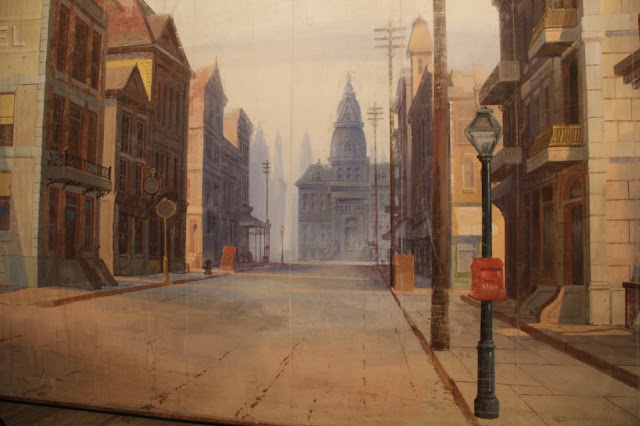Leadville has special meaning for me because one of my great-grandfathers, John Kee MacGowan, who had grown up a poor, orphaned immigrant boy in Philadelphia, somehow hooked up with the Guggenheim family in Colorado in the late 1890s, got hired, and ultimately became the first non-family partner of Guggenheims Bros., which was at the time the largest mining empire in the world.
My ancestor walked these streets...
As far as I can make out, there are no mines currently operating in Leadville. Once there were dozens. The last mine to close was owned by ASARCO, the American Smelting and Refining Co., which my great-grandfather worked for for more than 25 years. Here's his 20-year medal from the Utah Copper Company, a subsidiary of ASARCO
Here's the Tabor Opera House, established by one of the silver Kings, H.A.W. Tabor, who ultimately went bust:
Here's the stage backdrop, with a fanciful depiction of what Tabor hoped would be the Colorado capitol building. He hoped Leadville would become the state capitol.
Now we move onto some of the mining ruins on the outskirts of town. Some of these were Guggenheim mines.
Speaking of ghosts, there's an official ghost in Leadville--that of one-time State Senator Joseph Gallagher. He took a job in one of the most dangerous mines in Leadville, Moyer Mine, and died within two weeks in a mining accident. Blown up by a stick of dynamite!
Here's the house that Benjamin Guggenheim lived in. One of my grandmother's earliest memories was of traveling to Alaska by boat with her family and being met on the dock by a man in a huge bearskin coat--who turned out to be Ben Guggenheim. He later died on the Titanic.
The historic graveyard in Leadville is indeed an eerie place. Many of the oldest grave markers were made of wood, and they're in varying states of decrepitude. Some graves are ringed by metal fences. Others seem to have been restored and updated with new marble gravestones. There is no rhyme nor reason as far as I can tell. The entire graveyard has been overtaken by forest.















Shades of Baby Doe.
ReplyDeleteMy grandma and grandpa ran a hotel in Leadville. Mom, born 1913, ran around there as a little girl.
What a poorly written piece of garbage.
ReplyDelete